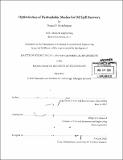| dc.contributor.advisor | Philip M. Gschwend. | en_US |
| dc.contributor.author | Prendergast, Daniel P. (Daniel Patrick) | en_US |
| dc.contributor.other | Massachusetts Institute of Technology. Department of Civil and Environmental Engineering. | en_US |
| dc.date.accessioned | 2013-12-06T20:48:55Z | |
| dc.date.available | 2013-12-06T20:48:55Z | |
| dc.date.issued | 2013 | en_US |
| dc.identifier.uri | http://hdl.handle.net/1721.1/82848 | |
| dc.description | Thesis (S.M.)--Massachusetts Institute of Technology, Department of Civil and Environmental Engineering, 2013. | en_US |
| dc.description | Cataloged from PDF version of thesis. | en_US |
| dc.description | Includes bibliographical references. | en_US |
| dc.description.abstract | Widespread use of petrochemicals often leads to accidental releases in aquatic environments, occasionally with disastrous results. Recent advances in the understanding of selectively wetting surfaces have led to the development of functionalized steel meshes with hydrophobic and oleophilic surfaces. These meshes can perform oil/water separation in situ, continuously, via capillary action. The goal of this study is to determine the potential of hydrophobic meshes as oil spill recovery devices. A fabrication method was developed using steel mesh dip-coated in a hot solution of low-density polyethylene (LDPE) in xylene. The mesh gained a rough, hydrophobic coating of LDPE, with tunable pore sizes and surface roughness. The coating was characterized using microscopy techniques and contact angle analysis, in order to identify surface features relevant to oil/water separation. Oil was found to persistently wet the mesh, attenuating any effects from roughness. Next, a key performance metric, the water breakthrough pressure, was predicted using a modified version of the Young-Laplace equation incorporating an unpinned meniscus. The model was successful for meshes with pore radii between 7 - 220 tm, which could hold back up to 40 cm of water. Finally, a bench-scale apparatus was built to test the oil permeate flux at steady state under capillary-driven flow. The mesh successfully recovered oil from the surface of a pool of water, with less than 1% water recovered by mass, with a representative flux of 1 L-m-²-s. These results were used to discuss implications for the feasibility of field-scale devices. | en_US |
| dc.description.statementofresponsibility | by Daniel P. Prendergast. | en_US |
| dc.format.extent | 68 pages | en_US |
| dc.language.iso | eng | en_US |
| dc.publisher | Massachusetts Institute of Technology | en_US |
| dc.rights | M.I.T. theses are protected by
copyright. They may be viewed from this source for any purpose, but
reproduction or distribution in any format is prohibited without written
permission. See provided URL for inquiries about permission. | en_US |
| dc.rights.uri | http://dspace.mit.edu/handle/1721.1/7582 | en_US |
| dc.subject | Civil and Environmental Engineering. | en_US |
| dc.title | Optimization of hydrophobic meshes for oil spill recovery | en_US |
| dc.type | Thesis | en_US |
| dc.description.degree | S.M. | en_US |
| dc.contributor.department | Massachusetts Institute of Technology. Department of Civil and Environmental Engineering | |
| dc.identifier.oclc | 863231865 | en_US |
